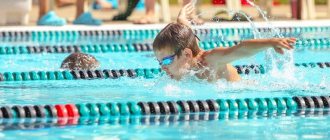Key benefits of infant swimming
This sport involves almost the entire major muscular system, minimizes the load on the spinal column, and improves the functioning of the cardiovascular, respiratory, and nervous systems.
For example, it helps to expand the lungs and increase their volume. It has been proven that children involved in this sport are less likely to get colds, and if they do get sick, it is in a milder form and for fewer days. And this is all due to the high heat capacity of water (that is, the heat loss in it is thirty times greater than in air). Thanks to this factor, this procedure has a hardening effect.
Swimming for infants helps improve metabolism, physical development, appetite, and sleep. These babies begin to roll over, sit, walk, crawl and talk faster, and in addition they develop correct posture.
This sport also helps increase hemoglobin levels (when the baby holds his breath, additional red blood cells are released into the blood).
How to determine whether a newborn baby can swim?
It is important that these procedures are allowed only after permission from doctors: pediatrician, orthopedist, neurologist! It is worth paying attention to this requirement so as not to harm the baby.
Being in the water is very comfortable for children at this age, and all because, “living” in their mother’s stomach, they swim in the amniotic fluid for a long time. Therefore, this procedure does not cause children any discomfort or feelings of fear. So, if the child is calm and has low muscle tone, water invigorates the baby and increases activity, and if he is overexcited, on the contrary, it calms and relaxes him.
It is recommended to begin these procedures immediately after the umbilical wound has healed (the first to third week after birth) or up to three months. This factor is very important due to the fact that babies at this age can reflexively hold their breath when water gets on their face. And if this reflex is not developed, then it fades away, and regular exercise in this sport strengthens and develops it. Therefore, it is very important to start classes as early as possible.
After these procedures have begun, you should definitely check your baby’s condition with a pediatrician every month, since only he will be able to assess the child’s physical development and the effect of these activities on the body.
Moral preparation
The first inscription that appears from the moment a child is born inside your heart and brain is: “Do no harm!” If further actions go through this censorship, everything should work out.
In order for classes to truly benefit both parents and baby, they must be calm and fun, in a comfortable and healthy environment for everyone. You don't pass an exam, you don't build the ninth wonder of the world, you don't go to the highest mountain on the globe. You don't need to injure your back by becoming a sacrifice for the sake of your child... Just play: do only what you can do today without fear and comfortably. Something that will bring you joy and real pleasure from your role as mom and dad.
Indications for infant swimming
Practicing this sport is recommended for almost all children (with the exception of a small group of patients), but for some of them it is extremely necessary.
These procedures are indicated for children:
- with hypertonicity (increased muscle tone). In warm water and a comfortable environment for him, the baby relaxes and calms down;
- with hypotonia (low muscle tone). In this condition, the baby is most often lethargic and inactive. Swimming helps strengthen the muscular system and tone it;
- with low body weight, that is, birth weight less than 2500 grams. These procedures increase the appetite of such babies, improve motor activity, sleep, adaptive capabilities of the baby, and also normalize the functioning of the nervous, cardiovascular, respiratory, and urinary systems. Such changes more often occur with intrauterine growth retardation and prematurity;
- with asymmetry of muscle tone. Constant changes of postures, namely flexion and extension movements in the limbs, contribute to the relaxation and tension of the baby’s muscular system and form the necessary motor sensations in them;
- those born by Caesarean section (“Caesareans”). Water helps to launch those mechanisms that were not launched at the time of birth and improves its adaptation to the environment;
- with dysplasia of the hip joints (that is, with their congenital inferiority). This type of procedure has a preventive effect on the joint-ligamentous apparatus, and also helps to strengthen the joints and independent movement in them;
This pathology occurs in 2–4% of all newborns. It is important to note that most often this method is not the main or replacement treatment. It is complementary.
- with valgus, varus, flat feet. The effect for these pathologies occurs due to the strengthening of the ligamentous apparatus and muscular system;
- with torticollis. Most often it is installation, that is, it occurs in utero or during labor, but it can also be true - arising from underdevelopment of the sternocleidomastoid muscle or as a result of a birth injury in the cervical spine. In the first case, this way you can relax the neck muscles, and in the second, this procedure is complementary to the main treatment;
- with cerebral palsy (CP). This procedure is the most optimal for them, since it involves both arms and legs. As a result, a reaction is achieved from these limbs, movements become more coordinated, rhythmic and consistent. It also eliminates painful sensations, improves the mental, physical, emotional and neurological state of the baby;
Infant swimming for children with this pathology is a mandatory and integral part of treatment. This procedure has a beneficial effect on the cardiovascular system, slows down muscle atrophy, reduces muscle tone, strengthens the child, and stimulates the baby’s sensory development.
- with problems with stool. This sport enhances intestinal motility; while the baby is swimming, the tummy is massaged, blood supply and the functioning of internal organs are improved.
Contraindications
But no matter how useful this sport is, it is not for everyone.
They are prohibited for children with:
- pneumonia, acute respiratory viral infections (ARVI), accompanied by hyperthermia;
- exacerbations of chronic diseases;
- skin diseases of an infectious nature;
- allergic manifestations on the skin;
- active form of tuberculosis, syphilis;
- diseases of the abdominal cavity that are prone to bleeding;
- epilepsy;
- severe congenital heart and kidney defects;
- dislocations and subluxations of the hip joints;
- congenital anomalies that exclude the ability to swim;
- acute cardiovascular, renal or liver failure;
- intestinal infections and intestinal disorders;
- hydrocephalus;
- open wounds;
- serious injuries and disorders of the musculoskeletal system, in which complete fixation of the limb is necessary.
Only a doctor should allow or prohibit a baby from engaging in this sport after a thorough examination and examination of the baby.
Frequently asked questions from moms and dads
When to start?
One of the rules for accustoming a baby to this procedure is the timely start of classes with him.
According to scientific data, the recommended age for training a child is less than three months, because after reaching it, innate reflexes fade away, one of which is the ability to swim. The best age to start classes with your child is one month.
Bath or pool?
Quite often, pediatricians are asked the following question: where is it better to start swimming with a child, in the bathtub or in the pool? Scientists' opinions on this matter are divided. Some believe that it is better to work with the baby at home until one or two months; in their opinion, adaptation to water in familiar conditions occurs faster. Others - from the age of three weeks it is recommended to visit the pool so that the baby gets used to a large volume of water.
But still, many coaches in this sport strongly recommend accustoming a child to it initially at home, so that he does not have a feeling of fear before immersion in water, diving, and also so that the child is as much as possible under the control of the parents/coach and in non-chlorinated water.
The College of European Pediatricians (Belgium, France, Germany) carried out research work in two thousand and ten. As a result, it was found that children who engage in this sport from birth have a fourfold greater risk of developing diseases of the respiratory system, compared to children who do not engage in it or rarely visit the pool.
The reason for this is the content of chlorine in the water, which is very harmful to the immature respiratory system, and during bathing it gets into the ears, nose, and sometimes into the mouth of the baby.
Is it always possible?
Before carrying out this procedure at home, it is necessary to assess the general condition of the child (mood, well-being, satiety).
If the baby cries, is hysterical or screams, it is recommended to postpone this procedure for some time (until his mood improves). The reason for this behavior can be fear, poor health, or hunger. Therefore, the optimal time for exercise is an hour after eating.
Coach or parent?
It is recommended to conduct the first lessons with a trainer, so parents can learn how to carry out this procedure correctly, learn the sequence of actions to perform it and will worry less about how correctly they are doing everything.
An important rule when performing these procedures is to accompany each exercise with your voice. So, for example, before dipping a baby into water, it is necessary to warn him about this. Due to this, the subconscious memorization of words occurs and the child’s readiness for certain actions is formed.
Necessary equipment
Swimming babies in the bathtub is not as boring as it might initially seem. Today there are many devices thanks to which the child can quickly adapt to this sport.
These include:
- rugs They are laid on the bottom of the bathtub so that the baby does not slip when stepping on it. They have a wide variety of colors and patterns. Thanks to this, they also attract the baby’s attention while swimming and interest him;
- circles , they are put on the child’s neck and do not allow him to choke;
- caps on the head. They are also worn to hold the baby’s head above the surface of the water;
- special panties. They need to be worn to avoid any unpleasant surprises in the pool, but you can do without them in the bathroom.
It is prohibited to teach your baby this procedure without knowing the basic principles and techniques of swimming, as this can be dangerous for your child. There is a possibility of water getting into the lungs.
Some tips
There are also small nuances that will expand parents’ knowledge about swimming with babies.
- The room in which classes will take place must have the same temperature as the rest of the house. It is advisable to leave the door open for the entire duration of the lesson.
- For more active activities, it is recommended to choose cool, but not cold water. For soothing - warm water. In the first case, the baby will behave cheerfully and actively, in the second - calmly and passively.
- When practicing, you need to carefully monitor the color of your child’s skin. Its color should either remain unchanged or acquire a soft pink tint.
Classes should bring pleasure to both mother and child . This is the only way to make this pastime fun and useful!
More information about infant swimming in the video:
Basic rules for infant swimming at home
Preparing a bath
Before starting this training, it is very important to properly prepare the place for it. To do this, you need to thoroughly wash the bathtub with baby or laundry soap, soda and rinse well with hot water, since the baby’s body has not yet adapted to the microorganisms around it.
It is forbidden to wash the bathtub with cleaning agents, as they can cause an allergic reaction in the baby.
Infants should swim in the bath in ordinary unboiled water. No special boiling or brewing of herbal infusions (chamomile, sage, calendula, etc.) is required.
It is recommended to place a special rubber mat with suction cups on the bottom of the bathtub (before this, you need to wash it thoroughly, just like the bathtub).
A pleasant-sounding melody during classes and/or a lot of bright toys floating in the water have a beneficial effect on the baby's learning process. They improve the baby’s mood and the desire to study longer.
Practicing this sport at home has a beneficial effect and prepares the child’s body to perform these procedures in the pool.
Temperature conditions of water and room
You should not immediately make the air and/or water temperature too low, trying to quickly get the effect of the procedure and harden the child. This whole process should be gradual, and a sharp temperature contrast can, on the contrary, aggravate the situation and cause hypothermia in the baby.
During the first lessons, the water should be at least 36 - 37 °C, with its subsequent reduction to 28 °C, and the air - 24 - 25 °C. The reduction in these indicators should be gradual. A weekly temperature reduction of 1 °C is recommended. If during bathing the baby begins to cry for a long time or anxiously, then you should not temporarily reduce these parameters. The average duration of this procedure at the beginning can be 9 - 15 minutes, and subsequently - 30 - 60 minutes.
When teaching a child to swim and lowering the temperature, there are several periods. Therefore, it is important to gradually and consistently increase the load on the baby’s body.
You should not start training if there are contraindications to it!
Permissible age of the baby
It is recommended to start classes with the baby as early as possible (as soon as the umbilical cord heals), that is, from 2 to 3 weeks of the baby’s life until three to four months of age (until unconditioned reflexes fade away). If classes are not started in a timely manner, they should be postponed until the age of three to four years.
To strengthen the swimming reflex, it is necessary to practice this sport at least until the age of three.
During training in the bath, another positive point is that you can regulate the required temperature of the water and thereby help harden the child.
It is important that children who engage in this sport from birth acquire skills that protect them from dangerous situations in the water in the future.
Recommended Exercises
Every year, the number of children whose parents decided to instill these skills in their little one is growing steadily. And this is due to its accessibility to a wide range of society. Classes require a bath, clean and warm water, certain parenting skills and persistent training.
After the instructor trains the parents, it is recommended to try the first procedure using a doll, and then with the baby under the strict supervision of the trainer.
It is forbidden to leave the baby unattended, as even in two or three seconds the baby can choke.
There are many exercises for infant swimming. Examples of several ways to perform them in the form:
- "Pushing off the wall." The hand must be placed in the area of the back of the baby's head. It must be placed on its tummy on the water. The baby's legs should touch the wall of the bathtub. After which he must push off from her. This exercise allows the baby to understand that the stronger the push from the wall, the further he will swim.
- "Chasikov." The child must be held by the armpits and gently immersed in the water. Then you need to swing it in it to the left and to the right. At first, this procedure must be performed slowly, and subsequently, gradually increase the amplitude of movements, touch the water with your cheek and add a “mermaid tail,” that is, increase leg lifts.
- "Vertical eights" The baby must be held, as in the second point, while drawing the baby’s body in a recumbent figure eight with its back and tummy.
- "Spoons." The child needs to be held by the armpits. Gently immerse your body in water and stir it with your body in all directions.
- "Splashing." Holding the baby's head by the chin, you need to carefully lower the baby into the water on his tummy, showing him how pleasant it is to splash. First you need to move his arms back and forth yourself, and then he will learn to do it on his own.
- "Swing." You need to hold the baby's head with your hand, and immerse the body in the water, belly down. Smoothly rocking the child's body back and forth, gradually immersing him in it and raising his body above the surface of the water.
Prepare a diaper or towel in advance before training, so that after training you can immediately wrap your baby in it and not get too cold.
Exercises and techniques
If a mother works with her baby only at home, this does not mean at all that the child will not be interested in an ordinary bath, and not a large swimming pool. To minimize the risk and ensure peace of mind, you can purchase a special circle or cap with foam that will allow your baby to float on the water independently. Using a circle will free up the mother’s hands for the most part, and make the child’s movements more relaxed.
READ ALSO: how to teach a baby to crawl at 5 months: Komarovsky’s video
The technique includes the following exercises:
- Pushes and turns. The baby needs to be brought closer to the walls of the container so that, feeling the support with his legs, he begins to push off and swim. Mom only needs to support him when he rolls over. A circle holding the head will also help and ensure safety.
- Splashing. When the baby lies on his stomach and his chin is supported by his mother's hand or circle, with his other hand the mother can show how the water trembles when splashing.
- Swimming. When the baby is lying in the same position, you can place a boat or another toy at a short distance in front of him and help the baby catch up with it. Each time the distance to the boat and the speed of movement need to be slightly increased.
- Zigzags and figure eights. You can start learning this exercise when swimming in a straight line has already been mastered. Now you need to, with the help of your mother, “draw” zigzags and “figure eights” on the water, turning over onto your back and tummy. Here, too, it is better to equip yourself with a swimming ring.
- "Swing". The baby must be placed on his stomach, and his head must be held with your hands or in a circle so that it is completely above the water. You need to guide the baby very smoothly so that he makes movements back and forth and up and down, plunging and rising.
To read: How to accustom a newborn baby to a pacifier at 1-3 months: is it possible and necessary to give a pacifier to a baby?
READ ALSO: how to properly wear a circle for bathing newborns?
Any mother can cope with such simple activities. To make it clearer what the exercises look like in practice, you can watch video lessons with an instructor in the pool.
Swimming with a baby in the pool
During classes, it will be clear which exercises he prefers. Therefore, it is worth starting each subsequent training with them in order to make the baby as comfortable as possible with this procedure.
Learning to swim for infants should not start right away in the pool. It is necessary to allow the baby’s body to adapt to the water and its temperature conditions, first in the bathroom.
If a child develops “goose bumps” or “marbled” skin, it is necessary to immediately take him to dry land, as these are symptoms of hypothermia.
If, while visiting the pool, your baby is scared and does not want to swim in it, sit on its steps or on the sides (give him time to adapt), and then gradually try to repeat the immersion in the water again. If the child’s anxiety and crying continue, cancel this activity and try again next time. Do not force it, as in this way you can create a feeling of fear of water in him.
Teaching newborns to swim immediately after birth is not recommended (unless the umbilical cord has healed).
After classes, you need to clean the baby’s ears so that no water remains in them, and if during the classes the baby swallows water, you need to drink it with a sorbent (Smecta, Enterosgel, Polysorb, etc.).
Baby diving in the bath
This element is the most difficult; you should move on to it only when all the basic techniques have been mastered. When starting it, you must clearly understand that the child has swimming skills and a breath-holding reflex, so you have nothing to be afraid of. How to do the exercise:
- Start with training. Clearly say the word “dive” to your baby and blow in his face. He will hold his breath and close his eyes. Perform the element for 10 days.
- Make the exercise more difficult. After the command “dive,” not only blow, but also splash the baby with water in the face.
- Go to the full element. First you need to learn to dive for a second or two, gradually increasing the duration.
All the pros and cons of infant swimming
The procedure should be performed 45–60 minutes after eating, when the baby still feels full, but the milk has been absorbed.
The advantages of this sport:
- during exercise, the newborn’s muscular system relaxes and its tone normalizes;
In water, the baby’s body weight is less, and this fact helps relieve the compression load on the spinal column and joints and stretch them during swimming, which helps strengthen muscles and accelerate growth.
- has a beneficial effect on the physical and neuropsychic development of the baby. The benefit of these procedures is that the child begins to sit, crawl, walk, stand, talk, etc. earlier;
- promotes hardening of the body, healing and strengthening of the immune system;
- normalizes the functioning of the nervous system (improves sleep, appetite, calms and relaxes the baby);
- improves the functioning of the digestive system (due to the fact that water “massages” the intestines, constipation and colic in the baby can be avoided);
- has a beneficial effect on the cardiovascular system and respiratory system (increases the vital capacity of the lungs, increases hemoglobin, etc.).
Disadvantages of these procedures:
- classes in the pool take place indoors with high air humidity and in chlorinated water, which predisposes to the development of bronchial asthma and allergic reactions to bleach in the form of dermatitis, etc.;
- they can contribute to the development of colds, otitis media, and frequent rhinitis. If the temperature is decreased incorrectly and in the presence of drafts, hypothermia may occur;
- there are few qualified specialists and good trainers in this area;
- Intestinal upset may occur if water is swallowed.
Despite all the pros and cons of these trainings, each parent, together with a doctor, must determine whether their child needs them or not.
Water temperature
The average temperature of the water when bathing should be 34-36 °C; as the child gets used to it, it should be lowered. Before 3 months, the water temperature cannot be less than 32 °C. If the liquid has cooled slightly during swimming, do not add warm liquid and bring it to its original state. This is how it should be, a gradual decrease in water temperature is a good way to harden the body.
An indicator of comfortable conditions will be the baby’s behavior:
- if the dive is accompanied by crying, then the water is too cold;
- if it is actively floundering in the water, the temperature is optimal;
- passivity and relaxation are an indicator of excessively warm liquid.
The newborn must be fed at least an hour before bathing. Swimming should be accompanied by constant communication with the baby.











